When Fitore Berisha steps into the room, she elicits a similar reaction as her paintings. Her signature black — almost extravagant — clothes, unusual hairstyle and prominent artsy jewelry call for a steady gaze, just like the faces, horns and colors that flow from her brush.
With a warm smile on her face, she approaches the table and says the last thing one expects: “I’m so pissed off!”
It could be a personal experience, a conversation she’s had, a confession or a piece of gossip she’s learnt; but whatever the precise trigger on this day, it is ultimately a story of women’s oppression. That is what makes her angry and she best knows how to respond to it through her artwork.
Her most recent exhibition took place in March at Prishtina’s trendy Menza Ramiz Sadiku bar. One of the paintings featuring an angry face sums up the contrasts between her looks and her feelings.
“This painting causes many people to psychoanalyse, because when they see Fitore she has make-up, fixed-up hair, she’s dressed up and she smiles,” she says. “But the face in the painting doesn’t match my face and people wonder where this anger comes from.”
She has also undoubtedly helped to bring something else: a female artistic perspective.
The visual artist, who has been working between Kosovo and Iceland for the past 20 years, once again treated human problems and obstacles from daily life that she’s witnessed during her many journeys in different places. The exhibition, called “Awakening,” was notable for its faces and upper bodies.
“I’m fascinated with the facial expressions that people have,” she says. “I analyze human faces so much that they unintentionally come to me through the work I do.”
She says she intended to bring out the emotions, the desperation and the expressions of those who surround her, but she has also undoubtedly helped to bring something else: a female artistic perspective.
It’s something that Kosovo has been increasingly seeing in recent years, whether through visual arts, dramatic arts or music as Fitore, together with many other Kosovar artists, have brought to the fore a strong — and long neglected — female voice, imprinting it into the country’s annals of art history.
Since the caveman era, art history has witnessed how the personal interacts with artistic expression and creativity. And Fitore is no exception, with her work adding to that of thousands of global artists who use their creative talents to question deep patriarchal structures.
Many paintings that Fitore has produced draw on unresolved issues in her life.
Pictures of big ears allude to her early childhood insecurities about her looks and being bullied; breasts are a metaphor for breastfeeding, or better, lack of it, which she links with the complex relationship she has with her own mother; while sad male faces allude to the vulnerabilities to which her own two sons may be exposed.
“When you think there is no way to come out, it explodes through the paper, pen and colors, and in this case through the horns too,” she once said.
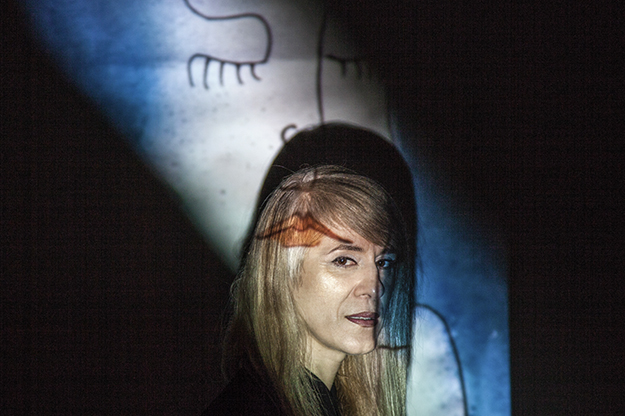
Fitore Berisha often expresses her anger at women’s oppression through her art. Photo: Majlinda Hoxha / K2.0.
Through many of her paintings, Berisha has called upon women to “let their horns emerge” in order to move beyond inequality, a symbol seen so frequently in her paintings.
When she was a child, at times when she felt like nobody was listening to her, her rebellious outrage would trigger a particular reaction from her mother. “Oh Fitore, the horns are about to come out,” her mother would say.
For Fitore, those horns are best expressed through her art, which she uses as therapy in order to understand her own past traumas and subsequent post-traumatic stress. “Art therapy is a healing process,” she says.
After some time, she revealed her whole childhood through her drawings of humans as creatures that don’t look like humans, but as different creatures with horns.
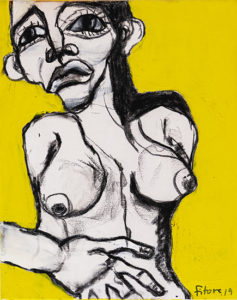
Fitore Berisha’s painting “Vulnerable.”
“It came to a point where I could do whatever I wanted; where I could show who I am,” Fitore said after a 2017 exhibition. “I could revolt and show the revolt straight to people’s faces.”
Dozens of feelings and emotions can be interpreted and identified through faces or body parts in her paintings, but each of them tells a familiar story of girls and women, or of “sisters,” as Fitore says.
“I don’t need, for example, to explain to anybody how this painting came about,” she says, pointing to a drawing of a hand on a vagina.
“It’s an unwanted hand and she’s terrified,” she says. “Maybe she is also married but doesn’t want sex. Maybe she wants to be loved, but not raped.”
Inherited trauma
In the same way as Fitore’s brushstrokes, Fatime Kosumi’s voice takes one to the exploration of narratives and stories of family and relationships between past and present over different generations.
Such a dimension has rarely been seen in the work of Kosovar artists — at least not in such a personal tone. The arts scene in Kosovo has long been dominated by men, whose relative freedoms perhaps naturally give them less inclination to consider such issues or to challenge the status quo than women who, from an early age, are expected to direct their lives within prescribed cultural norms.
Born in Rosenheim, Germany, as the daughter of Kosovar Albanian parents, Fatime left her German hometown in 2001 to move to Kosovo, where she lived until 2010.
After moving back to Berlin in 2011, her artistic identity as ANDRRA was born as her interest in old Albanian folk lyrics, and for incorporating them into her own music, began to grow. She describes the result as “pop-avantgarde.”
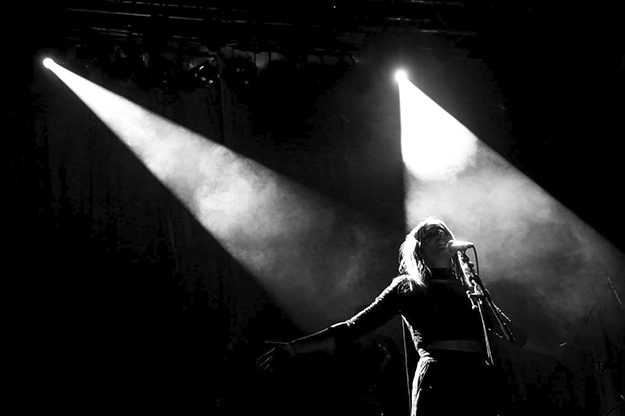
Fatime Kosumi, whose artistic identity is ANDRRA, explores issues such as child marriage, families and relationships in her musical performances. Photo: Somer Spat.
She found Albanian folk songs to be as courageous as the storytelling in blues music, and also drew parallels between the purveyors or each in that they both found popularity in poorer areas and amongst more marginalized social groups.
“I also liked the lyrics because they were more sincere, more authentic,” she told K2.0 back in 2017. “Rhapsodies are not necessarily beautiful, but they are genuine. And that is what I liked, the severe truth.”
But it was kanagjegj songs, which are sung to young girls who are brides-to-be, that caught Fatime’s attention for her own musical production. The songs, which are traditionally sung by women of the family one night before the wedding, feature many elements of uncertainty and insecurity for the future, as has been a common feeling for the majority of girls betrothed in arranged marriages, whether Albanian or from any other patriarchal culture.
Fatime found her own mother’s story in these songs.
“I think we, as women, have a collective trauma that we transmit with ourselves in our DNA,” she says.
“Why go and ask for an explanation somewhere distant when we can take it from our mothers, when we have the explanation so close? It was so important to understand my mother, because I wanted to understand the things that she taught us.”
During her concerts she owns the stage with a captivating presence, while the audience reads their own family stories in the words.
In order to compile songs based on kanagjegj lyrics she found many books published by Rilindja Publishing House in the 1980s, with verses compiled from different Albanian regions by writer and folklorist Anton Çetta. Finding no recorded melodies or rhythms, and therefore having little idea of how the songs were originally intended, Fatime took the texts and transformed them into powerful melodies and performances.
During her concerts she owns the stage with a captivating presence, while the audience reads their own family stories in the words that she spells out. “I think many people, also in concerts, they don’t understand the language but still get it,” she says.
Fatime recalls sitting in the sun at the beach years ago and observing a teenage boy and girl hanging out together. The duo, apparently friends, made her question the relationships she had built with men in her life. She reflected on whether she had had any male friends before she was 18 and concluded that she hadn’t.
“For me, the man always represented a potential danger, [someone] who either had requests of me, or I had them of him,” she says. “And it is why our mother, from a very young age, taught us to save ourselves.”
Dealing with the topics she treats in her songs has helped to liberate her from the constructed prejuducies and reflections she had about men, and her relationships with them. And most importantly, it liberated her from gender-constructed traumas over generations.
When she discovered kanagjegj lyrics for the first time it was like she herself was experiencing a child marriage, even though she personally hadn’t. “That’s when I say it is from collective trauma,” she says.
New take on old ideas
Although she doesn’t refer to inherited “trauma,” Doruntina Ukimeri is another Kosovar artist whose curiosity was stirred by cultural practices passed down by women through the generations.
In Kosovo the dowry has long been a big part of the life of young women, for whom embroidering pillowcases and tablecloths for their future married life traditionally made up a large part of a standard day. Over the years, the change of eras has seen a corresponding evolution in the display of the colorful needlework with the cloths finding their way onto television sets, in addition to walls, chairs and tables; the intricate handiwork still represents a prominent feature of most households.
“Dowry is like art,” Doruntina says. “You work and work for so many years on that and then you expose it in the end. In one way it’s like an exhibition.”
When she first brought her work on dowries in front of the public using a paper filigree technique this February, she didn’t know that it would spark so much interest, curiosity and discussion.
For over five years she had been investing a good proportion of her time in the paper filigree technique, with early mornings often finding her with paper filigree pieces ending in decorative designs.
When she embarked on her dowry work, it was a natural continuation of exploring themes that were present in her own life growing up.
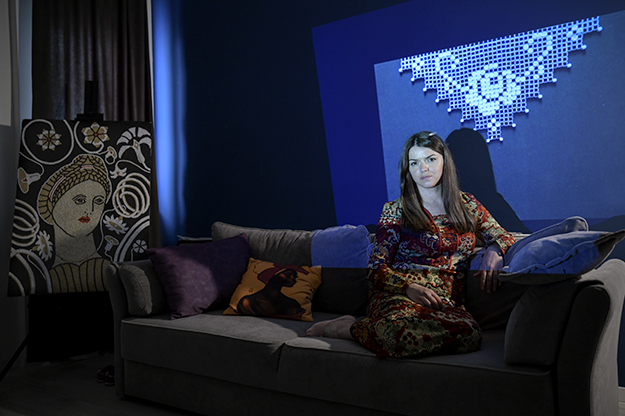
Artist Doruntina Ukimeri started her work on dowries out of personal curiosity and in doing so ended up opening up a previously overlooked discussion. Photo: Majlinda Hoxha / K2.0.
Often, her art would be framed by a recollection of her memories and those that had been passed down to her. Such was the case with her matryoshka work: portraits of women in her family distinctive in their different traditional dresses, marking various heritages from different Kosovo regions.
If they could speak they would tell their life stories, shaped by the historical developments of the 20th century. Enver Hoxha’s persecution of non-collaborators in Albania, where Doruntina’s family originate, drove some of her relatives to flee from northern Albania to Kosovo and girls were married off in different parts of Kosovo so they could not easily be tracked down.
“To some extent I also wanted to show the diversity of the Balkans,” she says. “That we are so different and the same at the same time.”
Until she had her first exhibition in 2017 in which she displayed a variety of her work up until that point, not many people were aware that Doruntina had a “side-job” besides being a full time architect. Following that experience, it was easy for her to make the decision of what to work on.
“I always found dowries beautiful,” she says. “All that handwork is an art in itself and I wanted to treat it like that.”
Independent settings also encourage debate about the themes being explored.
Doruntina embarked on a collaboration with Cultural Heritage Without Borders that had heritage promotion at its core and became particularly interested in exploring how the transformation of dowries happened in Albanian culture through the transformation of society and economy.
“In the past it was necessary for one to get prepared for a new life. Women needed to prepare everything from their underwear to wall decorations,” she says. “Today, if one needs anything you go to the shop and buy it. Actually there are many women who today run businesses by selling things that are part of the dowry.”
She herself has led workshops with women interested in learning the paper filigree technique and says that they might generate their own incomes from that one day.
In many ways, these workshops represent Doruntina passing forward to other women the opportunities that she has found through others who were willing to give an opportunity to those who struggle to find them in mainstream settings. With institutions such as the National Gallery still dominated by exhibitions by established male artists, Doruntina’s dowry exhibition was hosted by the small independent gallery Motrat, while other initiatives such as the annual FemArt festival are also increasingly providing exposure to women’s art.
Such independent settings also encourage debate about the themes being explored, with Doruntina’s exhibition followed by a rare discussion on the dowry in which sociologists raised the idea that dowries give women a sense of agency amidst patriarchal families and societies.
It wasn’t necessarily a conversation that Doruntina had initially set out to trigger when she first became interested in the topic, but became one that she was pleased to have helped enable.
“I’m very glad we are talking about this,” she says. “That this has opened these kinds of discussions.”
Diversifying narratives
Like Doruntina, Lendita Zeqiraj is another artist that is not necessarily driven by her gender to put gender issues and inequality into her art. She once said: “I don’t create as a woman. But as an artist.”
But just by virtue of being a woman she helps to present a diversity of insights. A glimpse into her latest short move “Fence,” brings characters to the fore that are rarely seen in Kosovar cinema: all are women protagonists from different generations.
“Every filmmaker chooses the approach that talks to them more,” she says. “If it’s said that my movies are closer to a woman’s perspective it is because I am a woman.”
If the medium of film is called the seventh art, then Lendita is the very personification of an artist that involves all other arts into hers.
When she was young she expressed herself through music and drawing, and she was even good in mathematics. She finished her studies in painting, but the affection for making film accompanied her from childhood when her father bought her and her siblings a Super 8 camera and a projector; she would later go on to study film aesthetics in Paris.
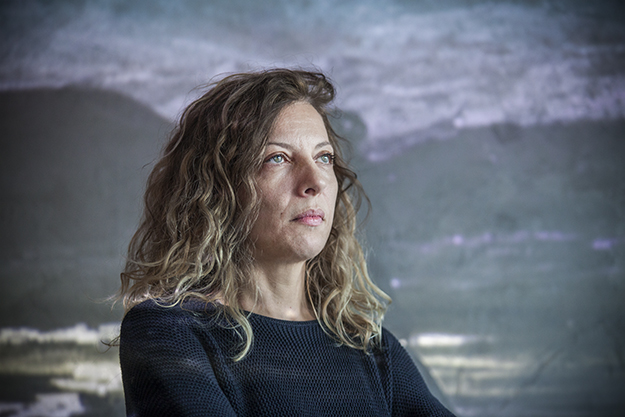
Lendita Zeqiraj says that being a woman perhaps inevitably brings a different perspective to her films than those by her male counterparts but that she sets out to create films only as an artist. Photo: Majlinda Hoxha / K2.0.
Now she is about to premiere her ninth film project and her first feature, “Aga’s House,” at the acclaimed Karlovy Vary Film Festival, while shorts like “Balcony” and “Fence” have already made their names at worldwide festivals and have brought home awards.
Watching her work one might have allusions of Inarritu’s work and Edward Hopper’s paintings. While the mexican filmmaker tells the story in one single long take, the painter was famous for his realistic portraits of American modern life; Lendita manages to portray daily moments of different people in one shot.
Child labor, poverty and discrimination are issues that the average Kosovar is forced to confront — if not personally, then likely in the space of a 20 minute walk anytime they leave the house — and so is the audience of Lendita’s movies.
Despite gender inequalities being a constant in Kosovar lives, they are rarely reflected as such in Kosovar cinema.
Internalized patriarchy, differences between generations, normalized gender-based domestic violence and crossing family norms surrounding relationships are also part of Lendita’s “Fence.”
“From the beginning, [girls] are taught to listen to their brothers, and always someone else is choosing for them and for their fate,” Lendita said in a 2018 interview for K2.0. “In the film, somehow, they are not self-censoring. They think they are doing the right thing, and having fun with it. It’s somehow a way to manage this violence, and being in this violent society.”
But despite gender inequalities being a constant in Kosovar lives, they are rarely reflected as such in Kosovar cinema.
As with other areas of the arts, the reasons for this are not hard to locate; until just a few years ago, from filmmakers to professors of film within the Faculty of Arts, it was almost exclusively men leading the film field.
But then, something changed. Amidst a male film culture, Kosovo Cinematography Center (KCC), the central authority for cinematography in Kosovo, began supporting women filmmakers on a similar scale to their male counterparts. Gradually women filmmakers have begun to transmit their own ideas, plots, compositions and storytelling.
By and large, Lendita feels that in recent years Kosovar cinematography has highlighted a diverse range of social topics, as a new generation of filmmakers — and amongst them plenty of women — have brought new perspectives to the big screen.
‘Being a woman is a rebellion’
The increasing diversity of issues being tackled as women have fought for opportunities within the arts has also been witnessed on Kosovo’s streets. The past five years have seen a rising number of youngsters and groups taking to the streets demanding positive action on different issues from sexism and employment without exploitation, to air pollution and homophobia.
Some of the most prominent feminist interventions in the public space have come from activism-based performances by the artistic collective Haveit.
The duo of sisters all studied at various branches of the University of Prishtina’s Faculty of Arts; all initially rebelled against their faculty.
“My biggest problem was to convince professors that directors can be women too,” says Haveit member Hana Qena, who originally registered for Theatre Directing. “The professor said: ‘You need balls to do theater, and you don’t have any.”
Unperturbed, the four young women tried to find an avenue for expression, without obstacles, fear or being stopped.
“We decided to find a space where you can express your thoughts, and you experience them as your own,” she says.
"Just the existence of four women in the street is rebellion itself.”
Hana Qena, Haveit
In reacting toward different violations and seeking a different audience to those inside the walls of theaters, museums and galleries, Haviet built up a completely new audience — everyday passersby.
Their first performance in 2011, as a reaction to the murder of Diana Kastrati — a young woman killed by her ex husband despite having requested police protection — paved the way to creating the identity of the collective, which became famous for its street performances.
“The rebellion is a very wide one, but I think that just the existence of four women in the street is rebellion itself,” Hana says.
“Just being a woman is a rebellion. You are forced to face different things all the time, you need to push for everything; it starts in your own house, [then] from the teacher that tells you: ‘Don’t talk because you’re a girl.’ The moment you decide not to serve tea to your brother, it’s a rebellion.”
Hana left the Faculty of Arts, although she knew that the decision would take her life in another direction — one that was less secure. She was conscious that gaining the space for expression would be more difficult as freelance artists as they would be without the networking opportunities that go hand in hand with being a student in the Faculty of Arts.
But when Hana stepped out into the street with Haveit the decision made sense. People started to show interest in their work, which could be felt through the public reaction and comments.
“You measure the pulse of the society; just the presence of your body, when you’re there — people will react,” she says. “You understand that a diploma doesn’t have any value. [With one], you can just find a stable job and be dependent on the professor and then on your boss.”

Hana Qena, part of artistic collective Haveit, says her university professor once told her: “You need balls to do theater, and you don’t have any.” Photo: Majlinda Hoxha / K2.0.
Haveit’s rebellion also marked another form of reaction and protest, one that in Kosovo is usually translated into marches and banners.
“We like to do performances that don’t show women as victims, even when they are killed or violated,” she says. “Our aim is to not treat them as victims, but to address the issue, in order for the court verdicts, the perpetrators and the killings to be addressed, but not the victim.”
For Hana and the group it also served as a way of problematizing the common portrayal of women as victims by Kosovo’s media, which to them just added another form of exploitation and victimization.
“There is sad music in the background in order to incite the feeling of death,” she says of the way in which survivors of abuse are often depicted. “[The media focus on] details of hands that suggest embarrassment and weakness. For us, it is not important how she moves her hands, but what she says.”
For Hana, the treatment of survivors of wartime rape is one of the best illustrations of the superficial and problematic representation of women, whether in daily news reports or in the theater and movies.
“Authors need to do a lot of research before treating such a delicate subject,” she says. “In some movies that I’ve seen, you see men and how they feel toward the [the raped] women; how the whole village feels about the raped person. Rape is not a shame. It can happen while you’re walking along the street. It cannot be treated as a state’s shame.”
“After performances with Haveit, the best thing is when young women write to us.”
Hana Qena, Haveit
As a theater director, Hana tries to present another portrayal, that of a very strong and powerful woman that doesn’t kill herself. In this way, she has transformed even the most tragic heroine of the theater world — Ophelia, from Shakespeare’s “Hamlet.”
Ending her adaptation of Heiner Müller’s “Hamletmachine” that she made for Kosovo’s National Theater in 2016, Ophelia declares: “Go to hell!”
Most recently, in her adaptation of Dario’s Fo famous play “Can’t Pay, Won’t Pay!” for the theater in Gjakova, she put on stage another set of women characters who revolt against increasing food prices.
For Hana, bringing a feminist approach to her work as a theater director, just like her art activism as part of Haveit, is all about having a positive impact and helping to challenge deep rooted perceptions.
“After performances with Haveit, the best thing is when young women write to us,” she says. “Having that effect on younger generations.”K
Feature image: Majlinda Hoxha / K2.0.

Back to monograph









This article is very interesting. I worked as a judge and Lawyer on international crimes in Bosnia-Herzegovina, Kosovo, Rwanda, Cambodia and Syria during most of my professional career. Survivors of core crimes have been at the center of my life. Art was then like a therapy for me. It all started when as a young judge in charge of juvenile in France I had hard time coping with the stories of children and families I was dealing with. Recently retired from the United Nations. I have relocated to Kosovo and opened L’Atelier 2.0 where I am producing oil and acrylic painting as well as watercolor from travels and family sceneries. I show some of my paintings on my instagram account latelier2.0: https://www.instagram.com/latelier2.0?igsh=MWpjdHp3aTB1NHI1NA%3D%3D&utm_source=qr